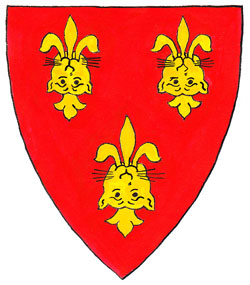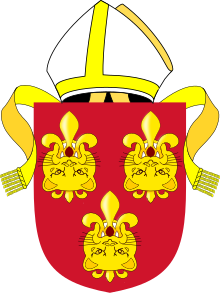
Feastday: October 2
Death: 1282
Bishop of Hereford, also called Thomas Cantilupe. Born at Buckinghamshire, England, circa 1218, he studied at Oxford, Paris, and Orleans. Returning to England, he became chancellor of Oxford University in 1261, using his influence to aid the barons in their struggle against King Henry III (r. 1216-1272). In 1265, after the defeat of Henry's forces at the battle of Lewes, Thomas was named chancellor of England, although he was soon compelled to retire to Paris after the barons lost their grip on power. Returning to Oxford, he served once more as chancellor of the university in 1273. Two years later he was appointed bishop of Hereford, acquiring a wide reputation for sanctity and charity and serving as one of the most capable counselors of King Edward I (r. 1272-1307). He also was a stern opponent of simony and all forms of secular encroachment upon his episcopal rights. His relationship with Thomas John Peckham, archbishop of Canterbury, deteriorated over matters of jurisdiction, culminating in Thomas' excommunication by the archbishop in 1282. He appealed to the papal court but died before any decision was reached by the pope. Despite the controversy, Thomas was revered in England and miracles were reported at his tomb; in 1320, he was canonized.
13th-century Bishop of Hereford and saint "Modern" arms of Thomas de Cantilupe: Gules, three leopard's faces reversed jessant-de-lys or. These arms were subsequently assumed by the See of Hereford
"Modern" arms of Thomas de Cantilupe: Gules, three leopard's faces reversed jessant-de-lys or. These arms were subsequently assumed by the See of Hereford
Thomas de Cantilupe (c. 1218 – 25 August 1282; also spelled Cantelow, Cantelou, Canteloupe, Latinised to de Cantilupo) was Lord Chancellor of England and Bishop of Hereford. He was canonised in 1320 by Pope John XXII.
Origins
Thomas was the third son of William II de Cantilupe (died 1251) (anciently Cantelow, Cantelou, Canteloupe, etc, Latinised to de Cantilupo), 2nd feudal baron of Eaton Bray in Bedfordshire, who was steward of the household to King Henry III (as his father William I de Cantilupe (died 1239) had been to Henry's father King John). Thomas's mother was Millicent (or Maud) de Gournai (died 1260), a daughter of Hugh de Gournai and widow of Amaury VI of Montfort-Évreux (died 1213), Earl of Gloucester. He was born at Hambleden in Buckinghamshire, a manor belonging to his mother's first husband but awarded to her during her lifetime as her dowry. Thomas's uncle was Walter de Cantilupe (died 1266), Bishop of Worcester.
Career
Cantilupe was educated at Oxford, Paris and Orléans, and was a teacher of canon law at the University of Oxford, where he became Chancellor in 1261.
During the Second Barons' War, Cantilupe favoured Simon de Montfort and the baronial party. He represented the barons before King Louis IX of France at Amiens in 1264.
On 25 February 1264, when he was Archdeacon of Stafford, Cantilupe was made Lord Chancellor of England, but was deprived of the office after de Montfort's death at the Battle of Evesham, and lived abroad for a while. Following his return to England, he was again appointed Chancellor of Oxford University, where he lectured on theology and held several ecclesiastical appointments.
Bishop of Hereford
 Mandorla-shaped seal of Bishop Thomas de Cantilupe. Legend: TOMAS DEI GRATIA HEREFORDENSIS EP(ISCOPU)S (Thomas by the grace of God Bishop of Hereford). The arms of Cantilupe ancient are displayed on each side of the bishop: three fleurs-de-lys. Hereford Cathedral Archives 6460. He stands on a wolf (Latin lupus), a canting charge seen on pre-heraldic seals of the Cantilupe family
Mandorla-shaped seal of Bishop Thomas de Cantilupe. Legend: TOMAS DEI GRATIA HEREFORDENSIS EP(ISCOPU)S (Thomas by the grace of God Bishop of Hereford). The arms of Cantilupe ancient are displayed on each side of the bishop: three fleurs-de-lys. Hereford Cathedral Archives 6460. He stands on a wolf (Latin lupus), a canting charge seen on pre-heraldic seals of the Cantilupe family
In 1274 Cantilupe attended the Second Council of Lyons and on 14 June 1275 he was appointed Bishop of Hereford, being consecrated on 8 September 1275.
Cantilupe was now a trusted adviser of King Edward I and when attending royal councils at Windsor Castle or at Westminster he lived at Earley in Berkshire. Even when differing from the king's opinions, he did not forfeit his favour.
Cantilupe had a "great conflict" in 1290 with the "Red Earl", Gilbert de Clare, 7th Earl of Gloucester, 6th Earl of Hertford, concerning hunting rights in Malvern, Worcestershire, and a ditch dug by de Clare. The issue was settled by costly litigation.
After the death in 1279 of Robert Kilwardby, Archbishop of Canterbury, a friend of Cantilupe's, and formerly his confessor, a series of disputes arose between him and John Peckham, the new archbishop. The disagreements culminated in Peckham excommunicating Cantilupe, who proceeded to Rome to pursue the matter with the pope.
Death, burial, and canonization
 The restored tomb of Thomas de Cantilupe in Hereford Cathedral
The restored tomb of Thomas de Cantilupe in Hereford Cathedral
Cantilupe died at Ferento, near Orvieto, in Italy, on 25 August 1282. He is buried in Hereford Cathedral. Part of the evidence used in his cause of canonization was the supposed raising from the dead of William Cragh, a Welsh rebel who was hanged in 1290, eight years after Cantilupe's death. A papal inquiry was convened in London on 20 April 1307 to determine whether or not Cantilupe had died excommunicate, since this would have precluded his being canonized. Forty-four witnesses were called and various letters produced, before the commissioners of the inquiry concluded that Cantilupe had been absolved in Rome before his death. It was difficult for his cause of death to be determined as much of his body had disintegrated.
After a papal investigation lasting almost 13 years, Cantilupe was canonized by Pope John XXII on 17 April 1320. His feast day was fixed on 2 October. His shrine became a popular place of pilgrimage, but only its base survived the Reformation until a new upper section (a feretory) was recently recreated under the guidance of architect Robert Chitham. The new section is in vivid colours with a painted scene of the Virgin and Child holding the Mappa Mundi. A reliquary containing his skull has been held at Downside Abbey in Somerset since 1881.
In the current Latin edition of the Roman Martyrology (2004 edition), Cantilupe is listed under 25 August as follows: "At Montefiascone in Tuscia, the passing of Saint Thomas Cantelupe, Bishop of Hereford in England, who, resplendent with learning, severe toward himself, to the poor however showed himself a generous benefactor".
Legacy
Cantilupe appears to have been an exemplary bishop in both spiritual and secular affairs. His charities were large and his private life blameless. He was constantly visiting his diocese, correcting offenders and discharging other episcopal duties, and he compelled neighbouring landholders to restore estates which rightly belonged to the see of Hereford. Cantilupe has been lauded as the "Father of Modern Charity," and is cited as an inspiration by Mother Teresa and Melinda Gates.
The Cantilupe Society was a text publication society founded in 1905 to publish the episcopal registers of the See of Hereford, of which Cantilupe's is the earliest to survive, and other records relating to the cathedral and diocese. It fell into abeyance after 1932.
Cantilupe is referenced in Graham Greene's novel Travels With My Aunt (1969), when the narrator's sharp-tongued aunt opines "I would have thought he was very lucky to die in Orvieto rather than in Hereford. A small civilized place even today with a far, far better climate and an excellent restaurant in the Via Garibaldi."
Notes
- ^ The commonly accepted modern spelling is "Cantilupe", as used by the Oxford Dictionary of National Biography for all members of this family, and which is followed in this article.
Citations
- ^ Dugdale, William (1656). The Antiquities of Warwickshire. London. pp. 504–5.
- ^ Sanders, I. J. (1960). English Baronies: A Study of their Origin and Descent 1086–1327. Oxford: Clarendon Press. p. 40.
- ^ Holden, B. W. (2004). "Cantilupe [Cantelupe], William de (d. 1251)". Oxford Dictionary of National Biography (online ed.). Oxford University Press. doi:10.1093/ref:odnb/4573. (Subscription or UK public library membership required.)
- ^ "Parishes: Hambleden", in A History of the County of Buckingham: Volume 3, ed. William Page (London, 1925), pp. 45–54 [1]
- ^ Walsh 2007, p. 598
- ^ Chisholm 1911, pp. 217–218.
- ^ Fryde et al. 1996, p. 85
- ^ Chisholm 1911, p. 218.
- ^ See Cantilupe seals discussed in M Julian-Jones, Thesis on de Cantilupe and Corbet families, 2015, Online Research @Cardiff (ORCA), Cardiff University [2]
- ^ Finucane 2004.
- ^ Fryde et al. 1996, p. 250
- ^ Nott, James (1885). Some of the Antiquities of Moche Malvern (Great Malvern). Malvern: John Thompson. p. 14. Retrieved 6 January 2010.
- ^ Bartlett 2004, p. 23
- ^ Bartlett 2004, p. 123
- ^ Pilgrimage page at Hereford Cathedral official website Archived 4 March 2016 at the Wayback Machine accessed 8 February 2012.
- ^ Unofficial translation. Cf. Martyrologium Romanum, ex decreto sacrosancti oecumenici Concilii Vaticani II instauratum auctoritate Ioannis Pauli Pp. II promulgatum, editio [typica] altera, Typis Vaticanis, A.D. MMIV (2004), p. 475.
- ^ "Parish and Community Magazine November 2017" (PDF). The Parishes of BROSELEY with BENTHALL and JACKFIELD & LINLEY with WILLEY and BARROW. 19 November 2017. Archived from the original (PDF) on 24 January 2018. Retrieved 25 December 2017.
- ^ "Cantilupe Society | The Online Books Page". onlinebooks.library.upenn.edu. Retrieved 26 December 2017.
- ^ "Cantilupe Society: Publications" (PDF). Royal Historical Society. Retrieved 29 May 2020.
- ^ Greene, Graham (1972) [1969]. "Chapter 18". Travels With My Aunt. Harmondsworth: Penguin. p. 151.





